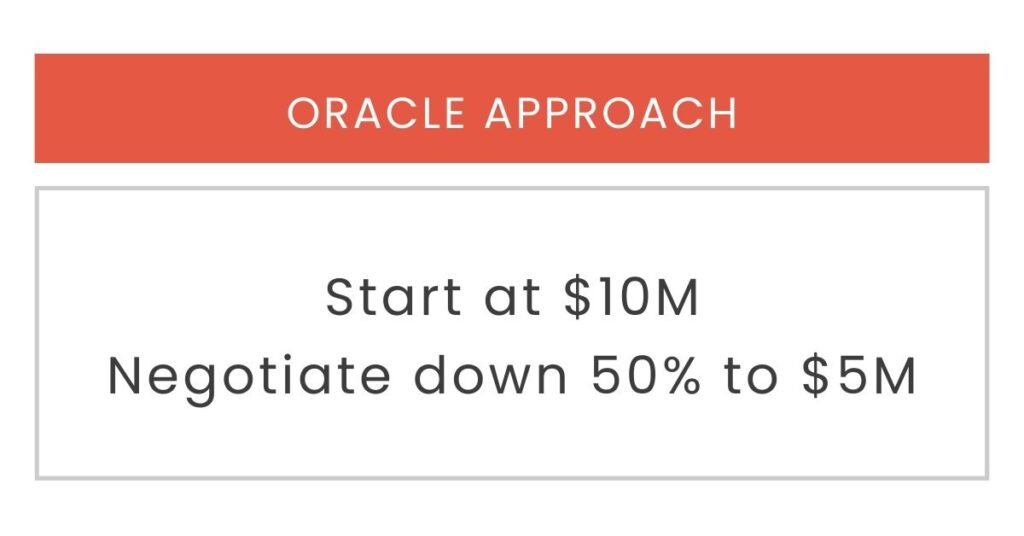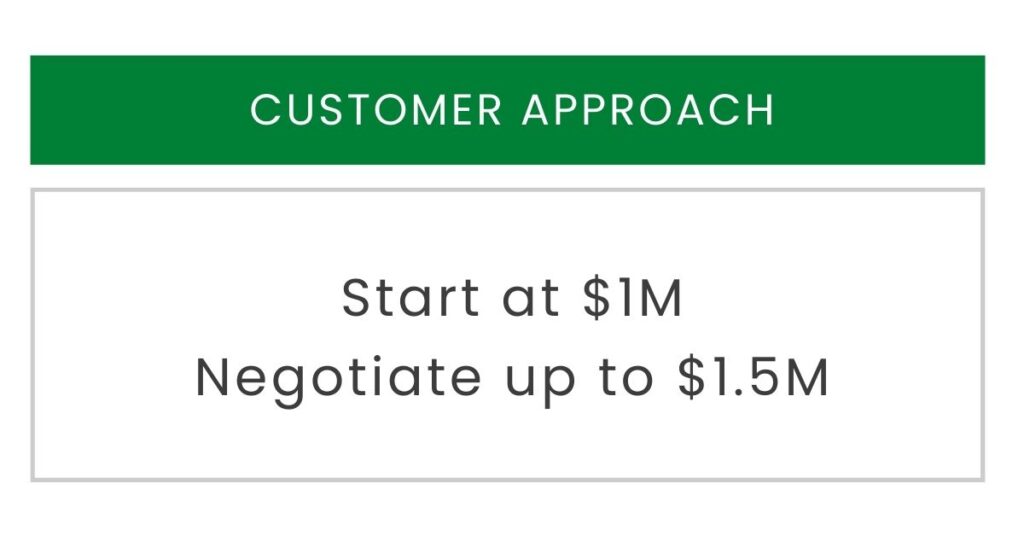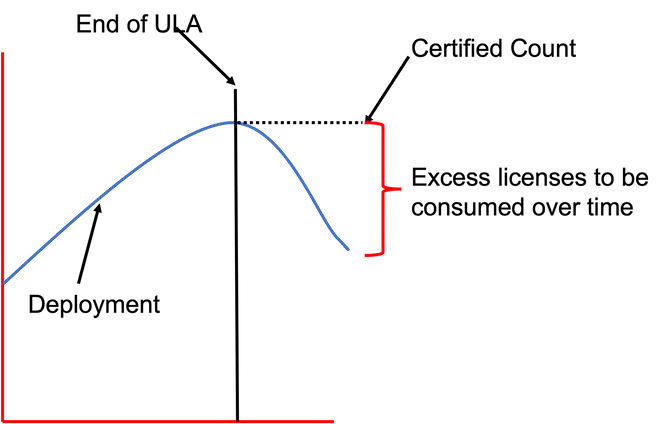ULA Instruction Manual
Table of contents
STAGE 1 – Negotiating and renegotiating your ULA
STAGE 2 – Oracle ULA management
STAGE 3 – ULA certification or renewal
Introduction
Oracle has been selling the Unlimited License Agreement (ULA) for over 20 years. During that time, they have modified, refined, and redesigned their ULA contracts, policies, and audit practices to their advantage. Oracle’s goal is to lock you into a never-ending cycle of ULA renewals and extract the most revenue from you until you are pushed into their cloud and spend even more with them.
Our ULA Instruction Manual is designed to give you the information you need to tip the balance of power in your favor, take control from Oracle, and regain the freedom over Oracle you require as your organization continues your digital transformation. Follow these instructions and you will get the most from your Oracle ULA and exit it on your terms.
This manual was developed by the Palisade Compliance team of experts. We leveraged our collective experience helping hundreds of clients negotiate, manage, and certify their ULAs to create this guidance that we use to empower our clients daily.
Palisade Compliance’s ULA services are designed to assist you in all phases of your ULA contract.
Stages of an Oracle ULA
To get the most from your Oracle ULA, you must manage three distinct stages of your contract. Each stage of your ULA presents a distinct opportunity for you to get more value out of your contract with Oracle. At the same time, however, these steps are also filled with pitfalls and traps that must be avoided or you will end up spending unnecessarily on a ULA renewal.
- Negotiating and renegotiating your ULA
- Optimizing your ULA
- Managing the last year of your ULA
These stages are not exclusive, and they often overlap. You can be in the middle of your ULA and renegotiating at the same time. Likewise, you may have just signed a ULA while you are making plans to exit.
STAGE 1
Negotiating and renegotiating your ULA
In this section of the ULA Instruction Manual, we review our best practices for negotiating the optimal ULA with Oracle. The advice here applies to negotiating your first ULA, a ULA renewal, or an amendment to your existing ULA.
Nothing sets you up for failure or success like negotiating the right terms and lowest price for your ULA. Getting your ULA pricing right provides the cost basis on which Oracle will base all future negotiations. The terms and conditions included in your ULA can give you the flexibility to deploy Oracle software as you see fit as well as the freedom to exit the ULA on your terms. The wrong terms and conditions, however, can be used by Oracle to extract more revenue, limit your ability to innovate and move to the cloud, and lock you into a never-ending cycle of ULA renewals.
The biggest ULA trap to avoid is the offer of help from Oracle’s audit team. Oracle has several names for their audit group including License Management Services (LMS), Global License Advisory Services (GLAS), and Software Investment Advisors (SIA), among others. Whatever they are calling themselves today, their goal is to get you to renew your ULA and buy Oracle cloud. They are absolutely not there to help you lower your Oracle costs.
ULA price negotiations
Every ULA price negotiation is custom and subject to the power and leverage you have over Oracle, or the leverage Oracle has over you. If you don’t need a ULA, and you can walk away without signing, then the price of your ULA will drop significantly. If, on the other hand, you’ve been found out of compliance, or you are unable to certify and exit your ULA, then the price of your ULA or ULA renewal will go up dramatically.
Follow these steps to get the lowest price on your ULA and ULA renewals:
- Maintain the flexibility to walk away from Oracle and say, “how about I give you nothing!” Watch Oracle’s reaction and their price drop when you maintain your freedom to not sign their ULA proposal.
- Always go first in your ULA negotiation. If you wait for Oracle to give you a price, you will always be negotiating down based on their position. You should go first in the negotiations with the lowest cost renewal. Make Oracle show value for the ULA to increase the price.
- Because there is no ULA price list, there are multiple ways to determine pricing. Processor usage, revenue growth, employee counts, budget availability, and prior spend are all valid methodologies to justify a price for your ULA. Use the strategy that works best for your firm.
- Companies that are in compliance with their Oracle licenses spend significantly less on their ULA and renewal than companies who are non-compliant. In fact, audits and non-compliance are a couple of the top reasons companies are forced to enter a ULA.
- Never let Oracle sales or audit groups (LMS, SIA, GLAS) tell you how many licenses you need. Unless it is in your contracts, never let them see script output. Never send them spreadsheets with hardware and virtualization details. We never want to hide non-compliance from Oracle. The reason we don’t send this information is because Oracle can always use it against you. They use it to gain power and leverage in their negotiations.


Negotiating terms and conditions
Despite having the word “Unlimited” in the name, the ULA is definitely not unlimited. The ULA only allows you to use a limited number of programs, to perform a limited number of functions, on a limited number of platforms. In fact, Oracle imposes additional contractual restrictions in the ULA that it does not impose in a standard non-ULA purchase of Oracle software.
The rules around optimizing your ULA pricing also apply to your terms and conditions. Maintain the freedom to walk away from your ULA and you will see Oracle be much more flexible in changing their contracts to meet your needs.
Unlike pricing, Oracle does maintain ULA contract standard terms and conditions. Despite these standards, Oracle lawyers like to change each ULA to fit their style and preferences. These legal driven changes actually provide Oracle customers with an opportunity to negotiate.
The terms and conditions that are best for your organization are specific to your business, compliance position, and company goals. Every clause in a ULA is open to negotiation. Nothing is off limits. We could write a book detailing every clause and option that is available to you. The following are two of the most critical clauses that require you to negotiate away from Oracle’s standard offering.
Customer definition
Oracle limits who can use ULA software with a highly restrictive customer definition that is anchored to a point in time “Subsidiary Exhibit”. This list of subsidiaries is perpetual and will cause you problems the first time you do a merger, acquisition, divestiture, or company reorganization. Your goal when negotiating with Oracle is to eliminate the subsidiary exhibit entirely, or to create a definition that is flexible. We do not recommend signing any ULA unless this has been accomplished.
Using Oracle products in the cloud
It’s no secret Oracle wants you to use their cloud. They are so intent on forcing you to the Oracle cloud that the ULA has morphed into a non-Oracle cloud prevention tool. Whether there are prohibitions on deploying in the cloud, certifying licenses in the cloud, or ambiguities on how to count licenses deployed in the cloud, Oracle has mastered the art of contract confusion. Your goal when negotiating your ULA is to remove all these ambiguities and restrictions. Your ULA should be clear and open to your cloud deployments. Failure to define cloud rights in your contract will cause you to overspend on Oracle in the future, and more troubling, lock out better (non-Oracle) technologies and put you at a competitive disadvantage.
Experience is critical when negotiating ULAs. To get a complete picture of the specific terms that are required in your ULA, please consult with a Palisade Compliance expert. We can help you review the Oracle ULA draft, understand your company goals, and negotiate optimal terms.
STAGE 2
Oracle ULA management
Once you sign a ULA it’s time to manage it. Your goal in managing your ULA is to ensure you exceed your deployment goals, stay in compliance, and have the ability to certify and exit your ULA. Oracle will often sell a ULA by stating that it’s “unlimited and does not have to be managed”. That gives the ULA customer a sense of complacency that leads to problems and unnecessary expenses. In fact, because your Oracle ULA is likely the most expensive Oracle license contract you have, you should manage it with a purpose, and more closely than you would smaller one-off Oracle license purchases.
Palisade Compliance has developed the following best practices to manage your ULA:

Sponsorship
Every company should have one person that is ultimately responsible for the success or failure of the ULA. Without executive sponsorship and internal support, your ULA deployments will drift into non-compliance, and you will be locked into a never-ending cycle of ULA renewals and cost increases.

Goals
Immediately after you sign a ULA, you should identify how many licenses you want to deploy during the term of that ULA. The higher the number the better for you. You’ve paid for an unlimited license, now is the time to deploy Oracle everywhere. Keep in mind, however, you want to stay in compliance as you deploy more Oracle.

Education
IT, Procurement, Legal, and executives should know what’s in your ULA, what’s not, what your goals are, and how you plan to achieve them. Ensure your entire team is on board. Everyone must move that ULA in the same direction.

Health checks
Both business and technical health checks are recommended every six months. You should not only count your Oracle usage with your IT team, but you should review things like the customer definition with your legal and M&A teams. Failure to conduct these health checks lead to unexpected and unpleasant surprises. Your goal is to have NO SURPRISES at the end of your ULA.

Certification and negotiations
This part of your ULA management takes place the last year of your ULA. It is so important we have dedicated the entire next section to helping you understand how to best certify and/or renew your Oracle ULA.
Failure to properly manage and optimize your ULA will lead to problems at the end of the contract. Inability to exit and certify, forced ULA renewal, and unbudgeted IT expenses are just a few of the likely outcomes. Even worse than all these, leaving your ULA without direction can result in your firm being locked out of new technologies and solutions and leave your company at a competitive disadvantage in the market.
STAGE 3
ULA certification or renewal
One year from the end of your ULA you should begin the certification process. Plan to deploy more licenses than you need to run your business. These licenses have been paid for so there is no risk in over deploying as long as you are doing it from a compliant position. The chart below represents the optimal deployment and certification from a ULA.

Negotiation path
Provided you can certify out of your ULA, Oracle will then be much more flexible negotiating a ULA renewal. Everything from pricing to terms and conditions are in play once you can certify and walk away from your ULA. Oracle only maintains negotiation leverage over you when you need the next ULA. In fact, all the rules and guidelines outlined above when negotiating a ULA can be applied at the end of the ULA in the renegotiation stage.
The last day of your ULA
The last day of your ULA is when you should decide whether or not you will certify your ULA or renew your ULA. It is on the last day of the ULA when you have Oracle’s best offer. It’s then up to you to decide if that offer is better than the certification you prepared. Making renewal and certification decisions earlier in your ULA term results in you paying more with less favorable terms than would have been available on the last day.
Following our dual path approach will leave you with a great choice to make. Do you sign this amazing ULA with favorable pricing and terms, or do you certify out of your ULA with maximum licenses and room to grow in years to come?
Do you need further help with your ULA?
Palisade Compliance has a variety of services designed to help you at any stage of your ULA. We have assisted hundreds of clients in their ULA negotiations, management and certification. Contact us today and talk to one of our experts, discuss your Oracle ULA challenges, and learn how we can help you get the most from your Oracle ULA.
